CHEVROLET BLAZER 1996 2.G Owners Manual
Manufacturer: CHEVROLET, Model Year: 1996, Model line: BLAZER, Model: CHEVROLET BLAZER 1996 2.GPages: 392, PDF Size: 20.35 MB
Page 241 of 392
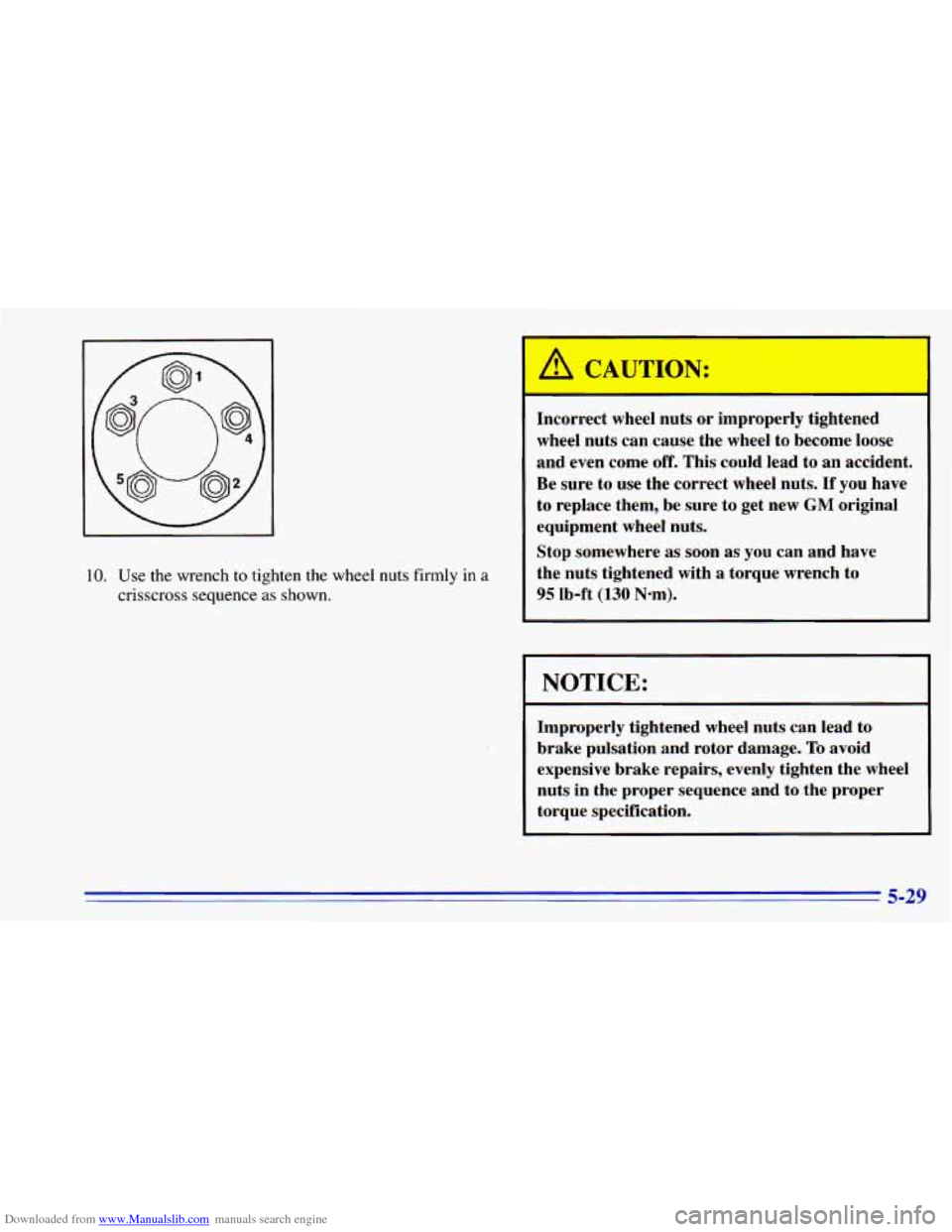
Downloaded from www.Manualslib.com manuals search engine 10. Use the wrench to tighten the wheel nuts firmly in a
crisscross sequence as shown. Incorrect
wheel nuts or improperly tightel
I
wheel nuts can cause the wheel to become loose
and even come
off. This could lead to an accident.
Be sure to use the correct wheel nuts.
If you have
to replace them, be sure to get new
GM original
equipment wheel nuts.
Stop somewhere as soon
as you can and have
the nuts tightened with a torque wrench to
95 lb-ft (130 Nom).
I NOTICE:
Improperly tightened wheel nuts can lead to
brake pulsation and rotor damage.
To avoid
expensive brake repairs, evenly tighten the wheel
nuts in the proper sequence and to the proper
torque specification.
5-29
Page 242 of 392
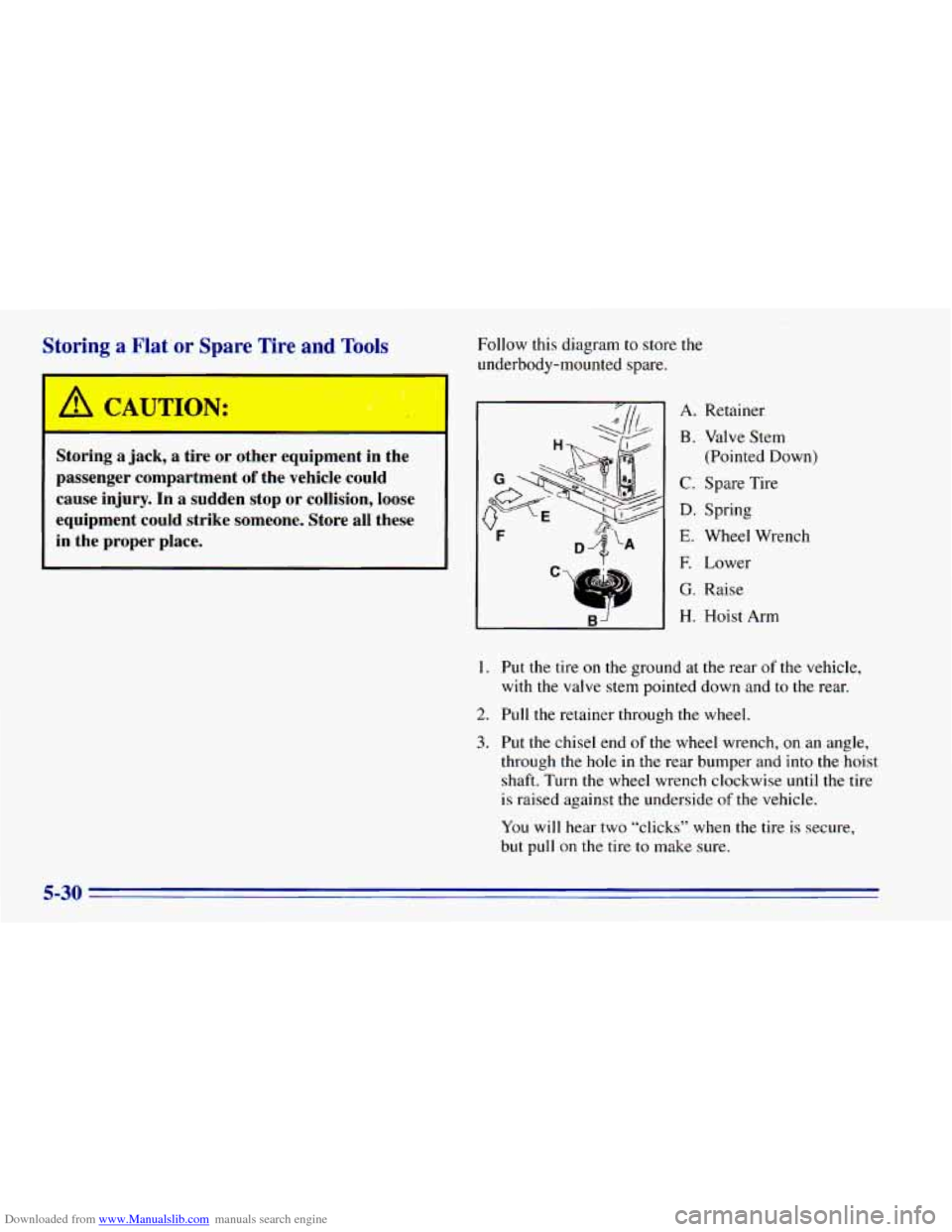
Downloaded from www.Manualslib.com manuals search engine Storing a Flat or Spare Tire -..ne Tn4s
Storing a jack, a tire or other equipment in the
passenger compartment
of the vehicle could
cause injury. In a sudden
stop or collision, loose
equipment could strike someone. Store all these in the proper place.
Follow this diagram to store the
underbody-mounted spare.
cTD B
A. Retainer
B. Valve Stem
(Pointed Down)
C. Spare Tire
D. Spring
E. Wheel Wrench
E Lower
G. Raise
H. Hoist Arm
1. Put the tire on the ground at the rear of the vehicle,
with the valve stem pointed down and
to the rear.
2. Pull the retainer through the wheel.
3. Put the chisel end of the wheel wrench, on an angle,
through the hole
in the rear bumper and into the hoist
shaft. Turn the wheel wrench clockwise until the tire
is raised against
the underside of the vehicle.
You will hear two “clicks” when the tire is secure,
but
pull on the tire to make sure.
5-30
Page 243 of 392
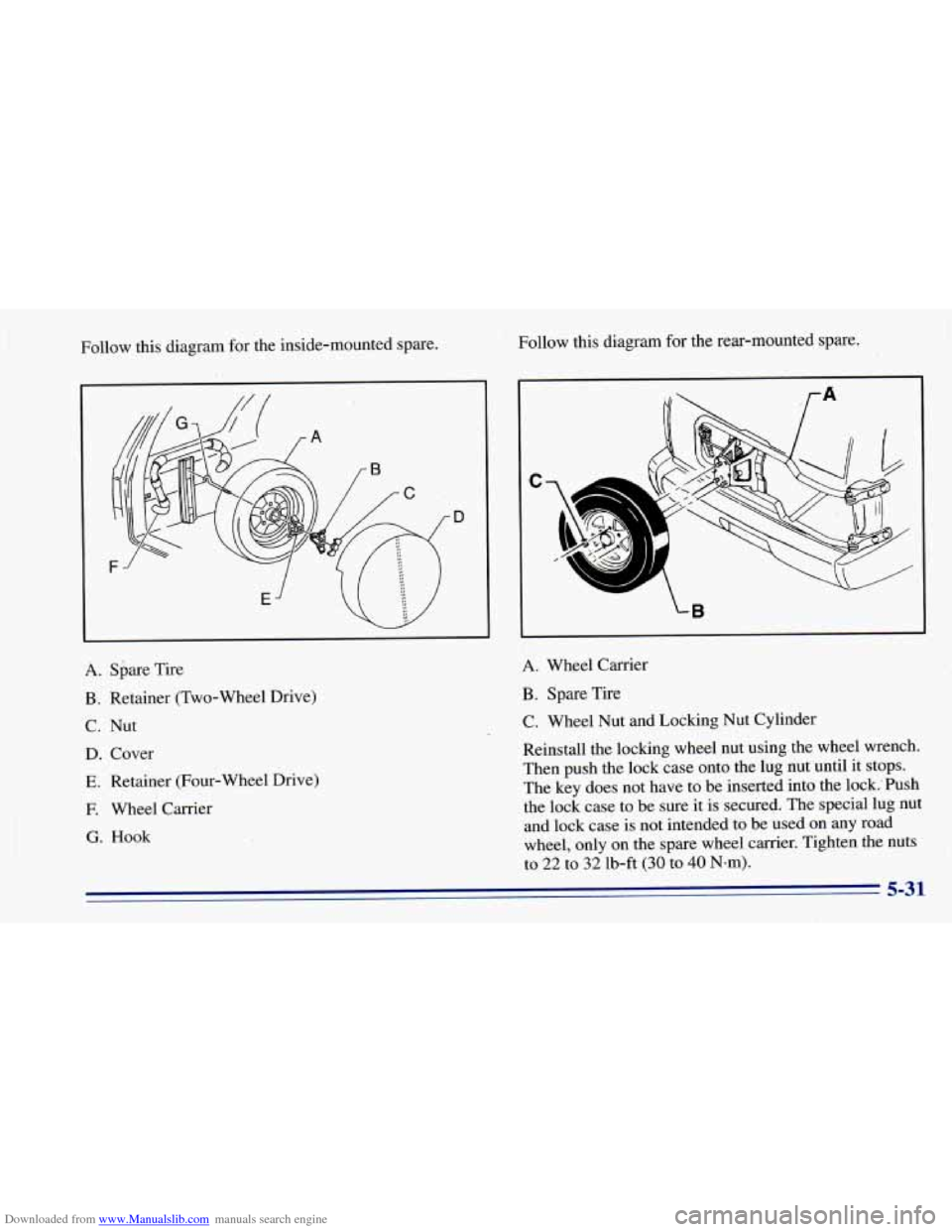
Downloaded from www.Manualslib.com manuals search engine Follow this diagram for the inside-mounted spare.
D
A. Spare Tire
B. Retainer (Two-Wheel Drive)
C. Nut
D. Cover
E. Retainer (Four-wheel Drive)
E Wheel Carrier
G. Hook Follow this diagram
for the rear-mounted spare.
A. Wheel Carrier
B. Spare Tire
C. Wheel Nut and Locking Nut Cylinder
Reinstall the locking wheel nut using the wheel wrench.
Then push the lock case onto the lug nut until it stops.
The key does not have to be inserted into. the 1ock:Push
the lock case
to be sure it is secured. The special lug nut
and lock case is not intended to be used on
any road
wheel, only on the spare wheel carrier. Tighten the nuts
to
22 to 32 lb-ft (30 to 40 N-m).
5-31
Page 244 of 392
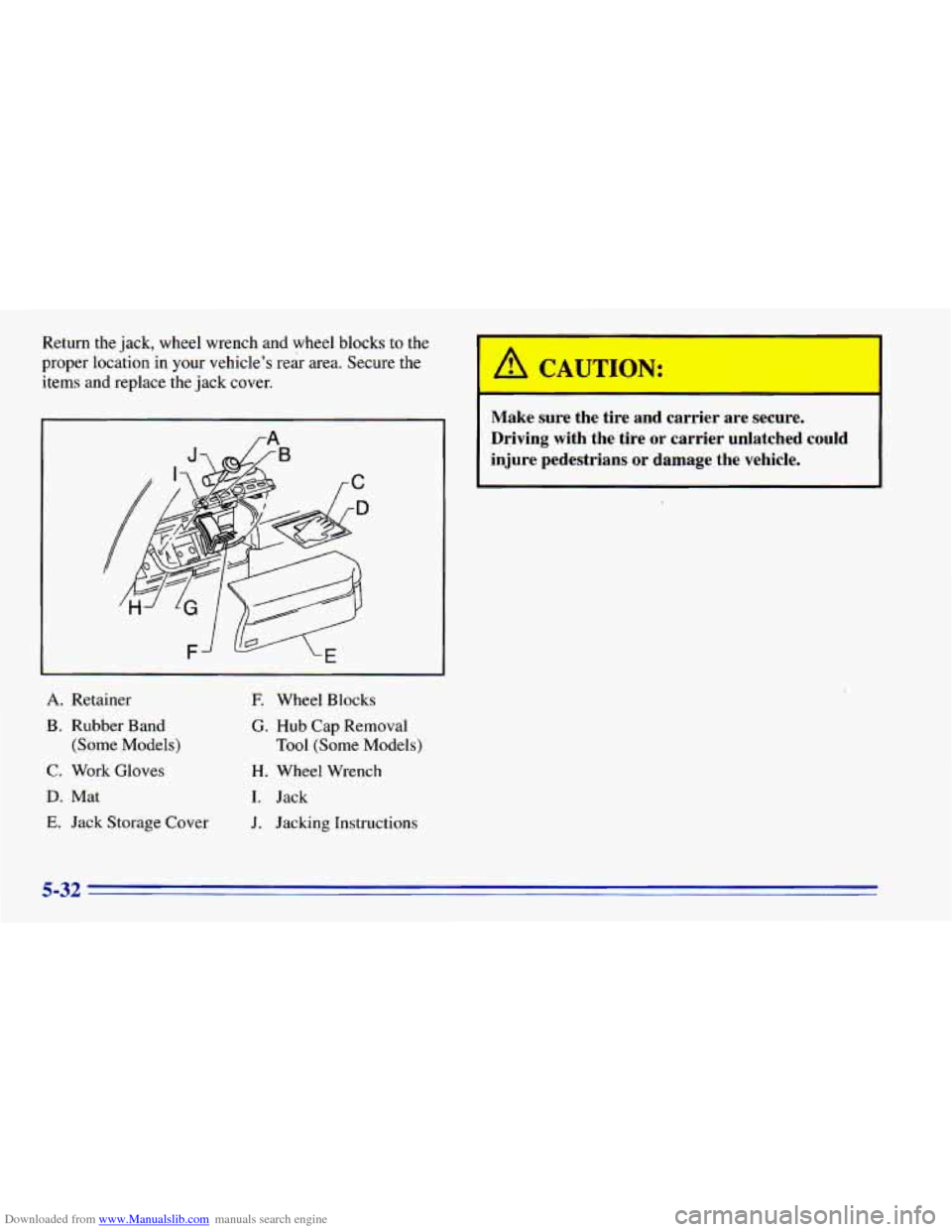
Downloaded from www.Manualslib.com manuals search engine Return the jack, wheel wrench and wheel blocks to the
proper location in your vehicle’s rear area. Secure the
items and replace the jack cover.
A. Retainer
B. Rubber Band
(Some Models)
C. Work Gloves
D. Mat
E. Jack Storage Cover
E Wheel Blocks
G. Hub Cap Removal
H. Wheel Wrench
I. Jack Tool
(Some Models)
J. Jacking Instructions
I A CAUTION:
Make sure the tire and carrier are secure.
Driving with the tire or carrier unlatched could
injure pedestrians
or damage the vehicle.
5-32
Page 245 of 392
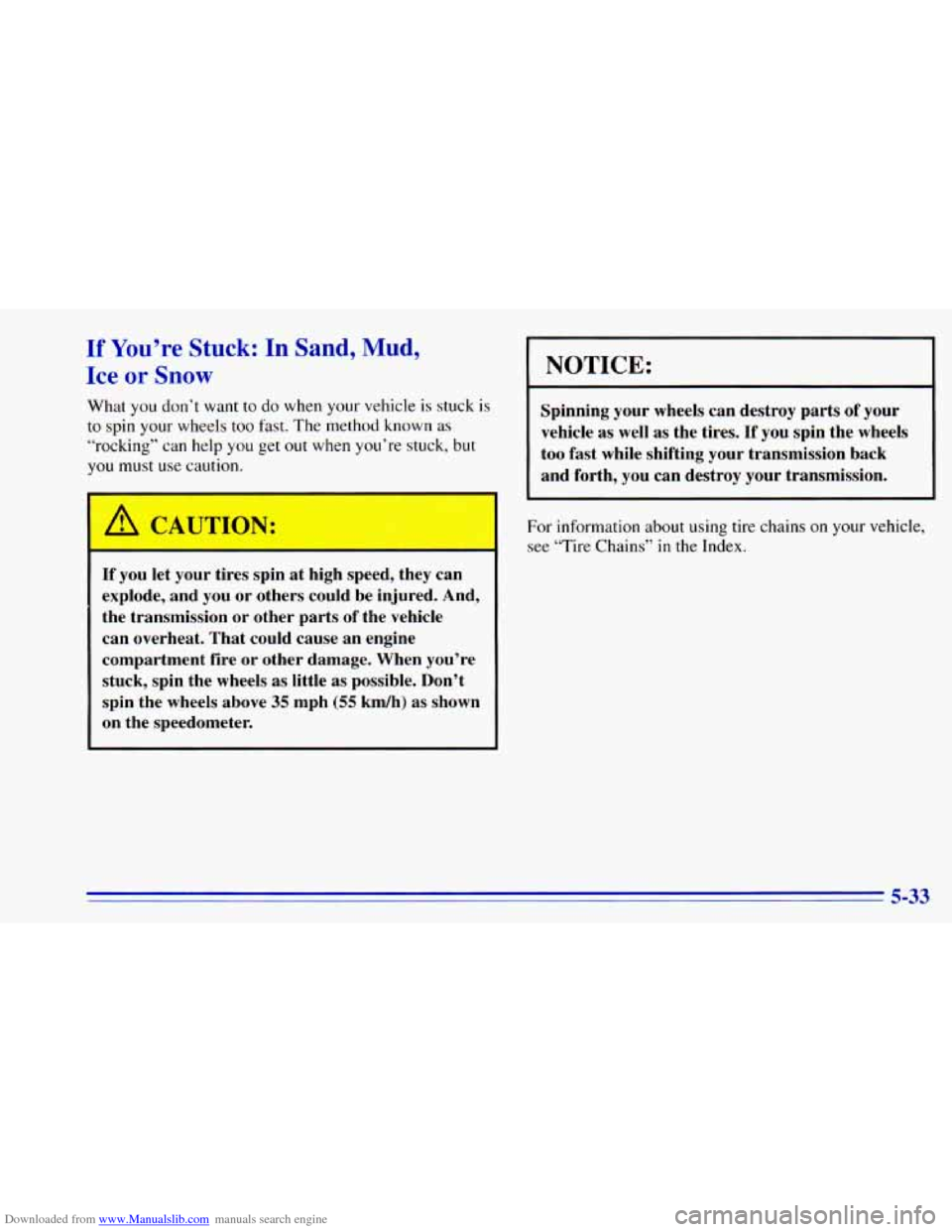
Downloaded from www.Manualslib.com manuals search engine If You’re Stuck: In Sand, Mud,
Ice or Snow
What you don’t want to do when your vehicle is stuck is
to spin your wheels too fast. The method known as
“rocking” can
help you get out when you’re stuck, but
you must use caution.
A CAUTION:
If you let your tires spin at high speed, thej In
explode, and you or others could be injured. And,
the transmission or other parts of the vehicle
can overheat. That could cause an engine
compartment fire or other damage. When you’re
stuck, spin the wheels
as little as possible. Don’t
spin the wheels above
35 mph (55 kmh) as shown
on the speedometer.
NOTICE:
Spinning your wheels can destroy parts of your
vehicle as well
as the tires. If you spin the wheels
too fast while shifting your transmission back
and forth, you can destroy your transmission.
For information about using tire chains on your vehicle,
see “Tire Chains” in the Index.
5-33
Page 246 of 392
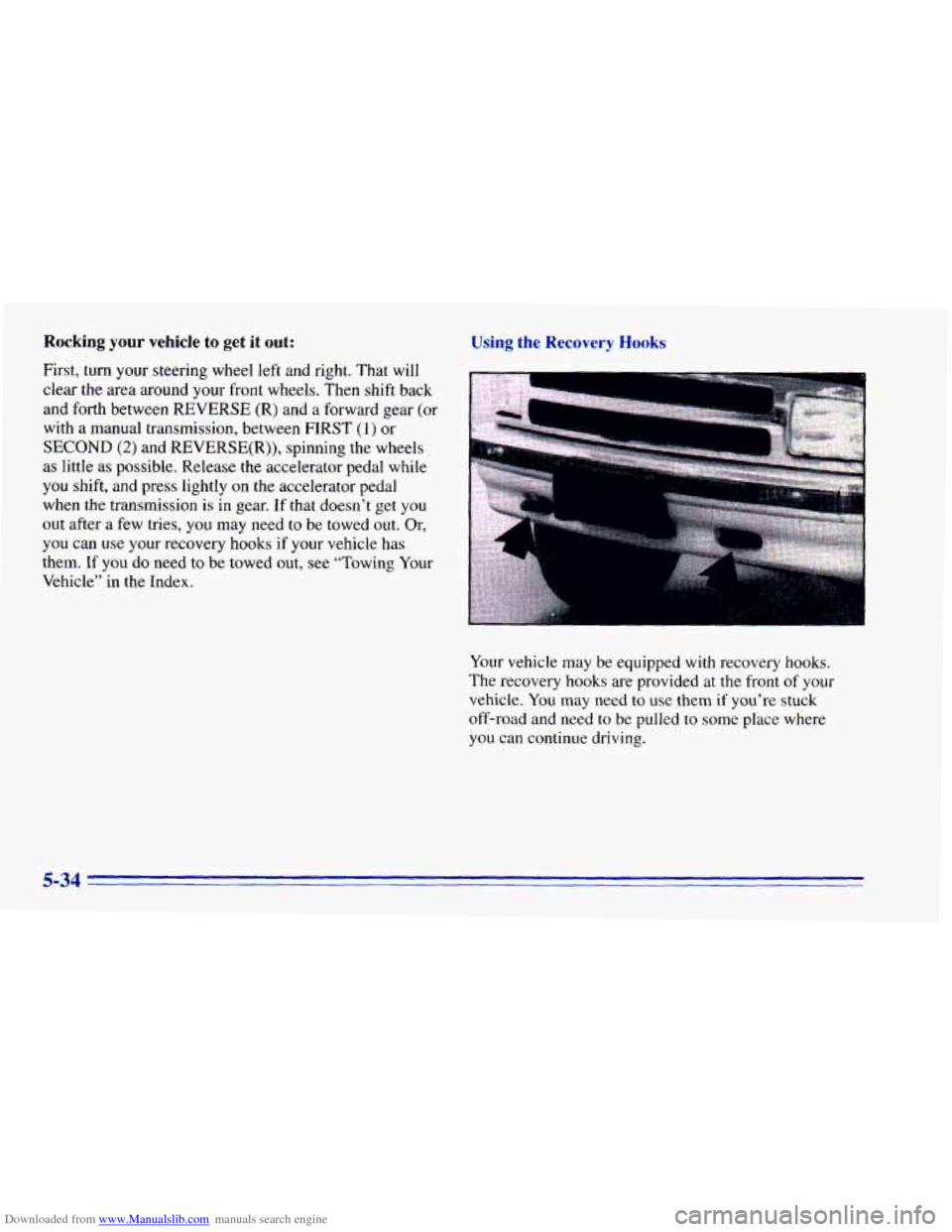
Downloaded from www.Manualslib.com manuals search engine Rocking your vehicle to get it out:
First, turn your steering wheel left and right. That will
clear the area around
your front wheels. Then shift back
and forth between REVERSE (R) and a forward gear (or
with a manual transmission, between FIRST
(1) or
SECOND (2) and REVERSE(R)), spinning the wheels
as little as possible. Release the accelerator pedal while
you shift, and press lightly on the accelerator pedal
when the transmission is in gear.
If that doesn’t get you
out after a few tries, you may need to be towed out. Or,
you can use your recovery hooks if your vehicle has
them. If you do need
to be towed out, see “Towing Your
Vehicle” in the Index.
Using the Recovery Hooks
.“ .
Your vehicle may be equipped with recovery hooks.
The recovery hooks are provided at the front of your
vehicle.
You may need to use them if you’re stuck
off-road and need
to be pulled to some place where
you can continue driving.
i
5-34
Page 247 of 392
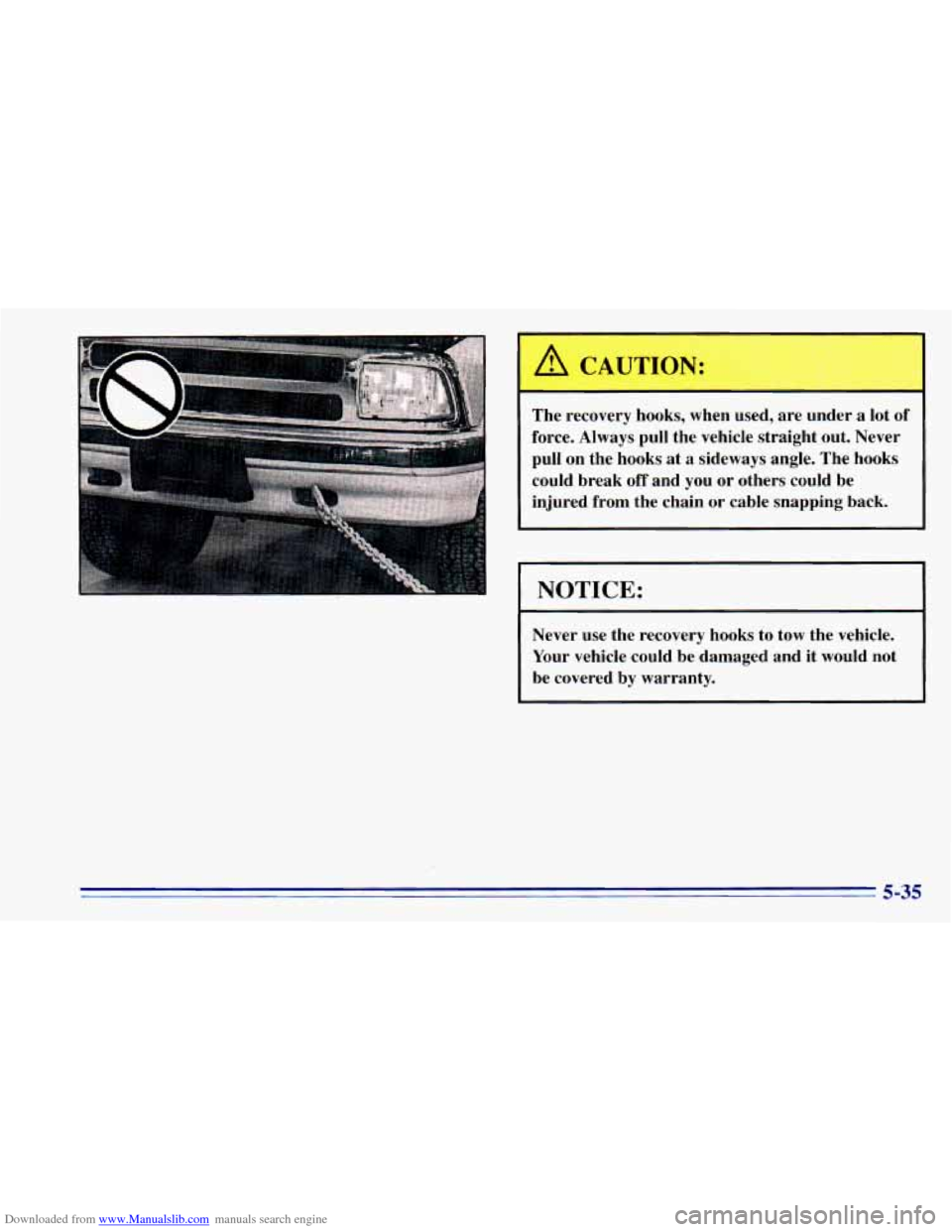
Downloaded from www.Manualslib.com manuals search engine The recovery hooks, when used, are under a lot of
force. Always pull the vehicle straight out. Never
pull on the hooks
at a sideways angle. The hooks
could break
off and you or others could be
injured from the chain
or cable snapping back.
NOTICE:
Never use the recovery hooks to tow the vehicle.
Your vehicle could be damaged and it would not
be covered by warranty.
5-35
Page 248 of 392
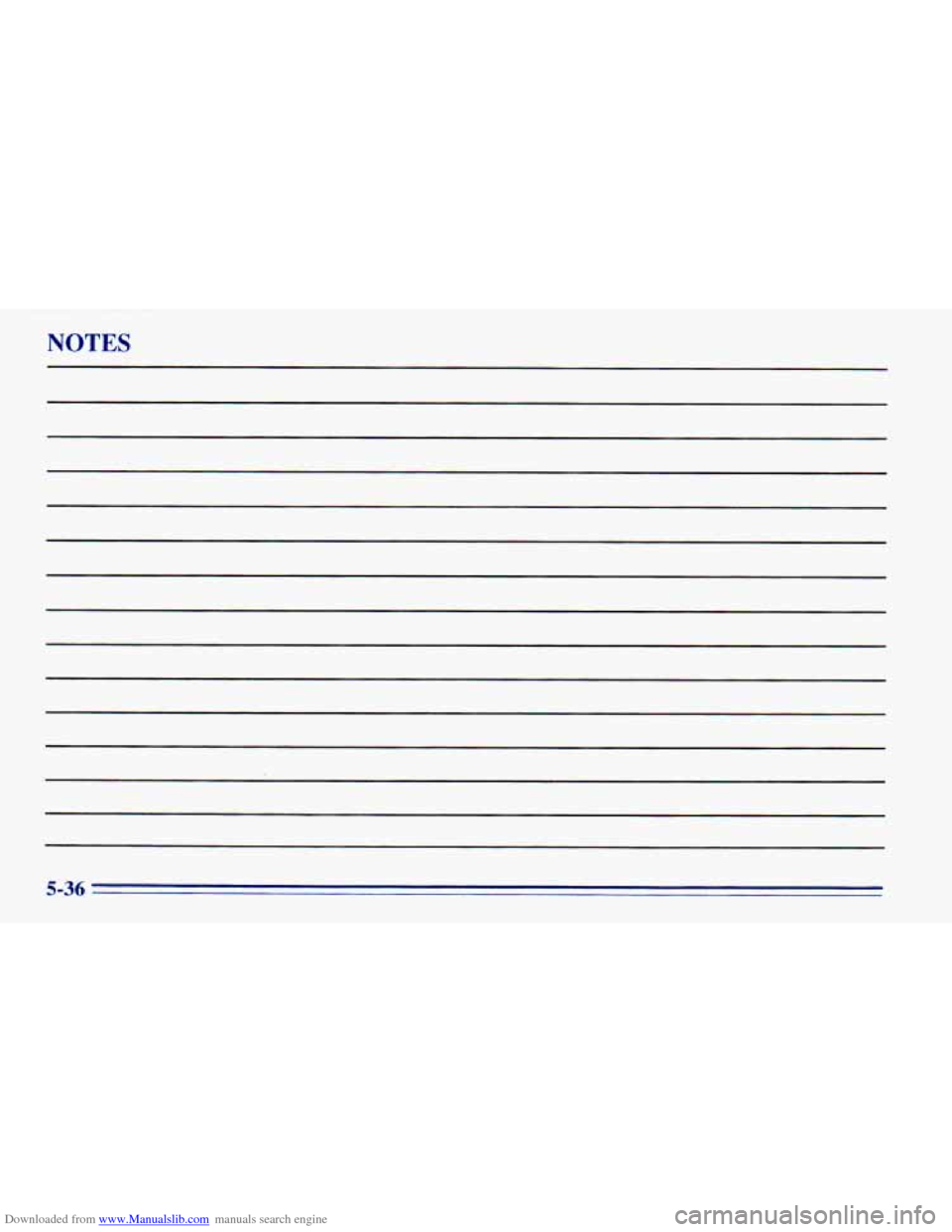
Downloaded from www.Manualslib.com manuals search engine NOTES
5-36
Page 249 of 392
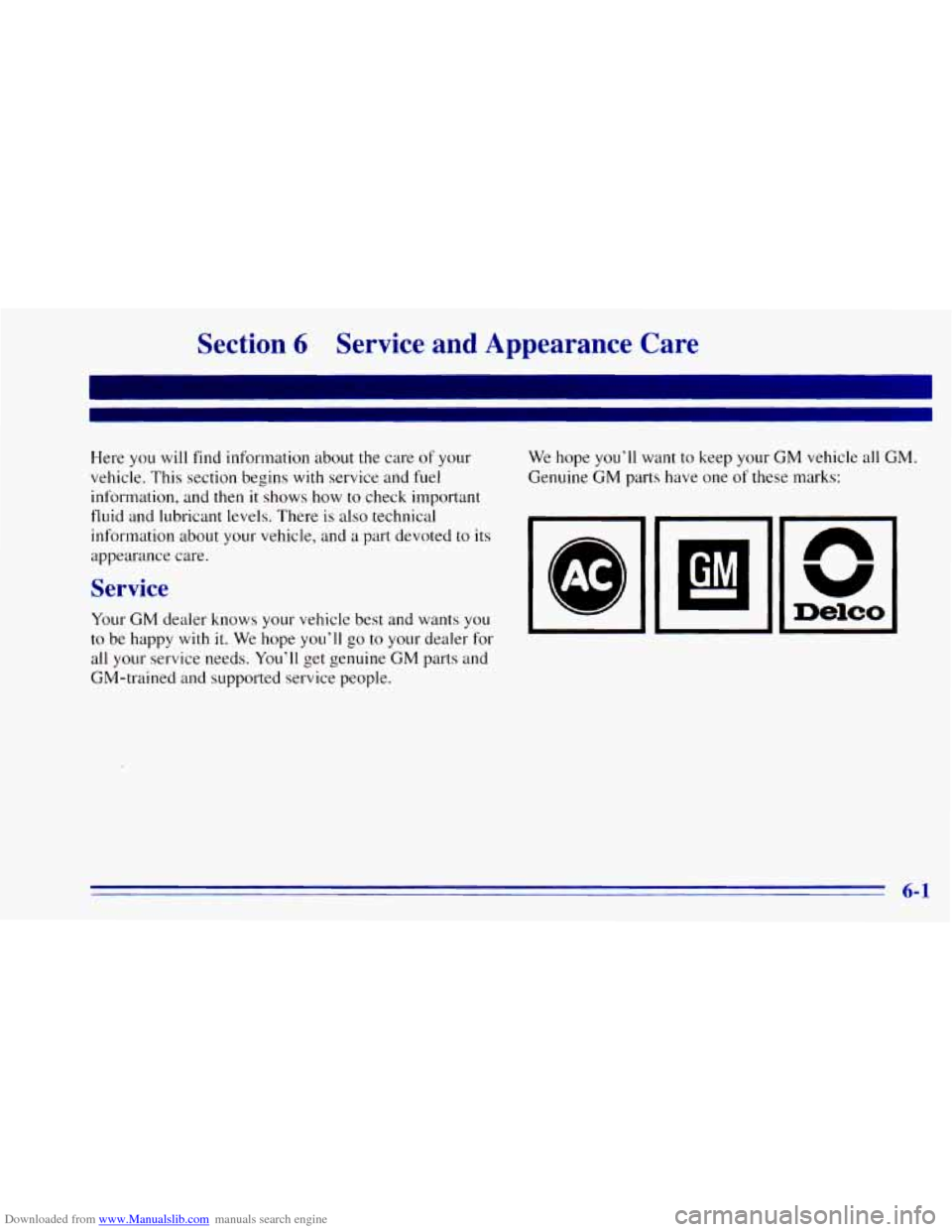
Downloaded from www.Manualslib.com manuals search engine Section 6 Service and Appearance Care
Here you will find information about the care of your
vehicle. This section begins with service and fuel
information, and then
it shows how to check important
fluid and lubricant levels. There is also technical
information about your vehicle, and
a part devoted to its
appearance care.
Service
Your GM dealer knows your vehicle best and wants you
to be happy with it. We hope you’ll go to your dealer for
all your service needs. You’ll get genuine GM parts and
GM-trained and supported service people. We
hope you’ll want
to keep your GM vehicle all GM
Genuine GM parts have one
of these marks:
6-1
Page 250 of 392
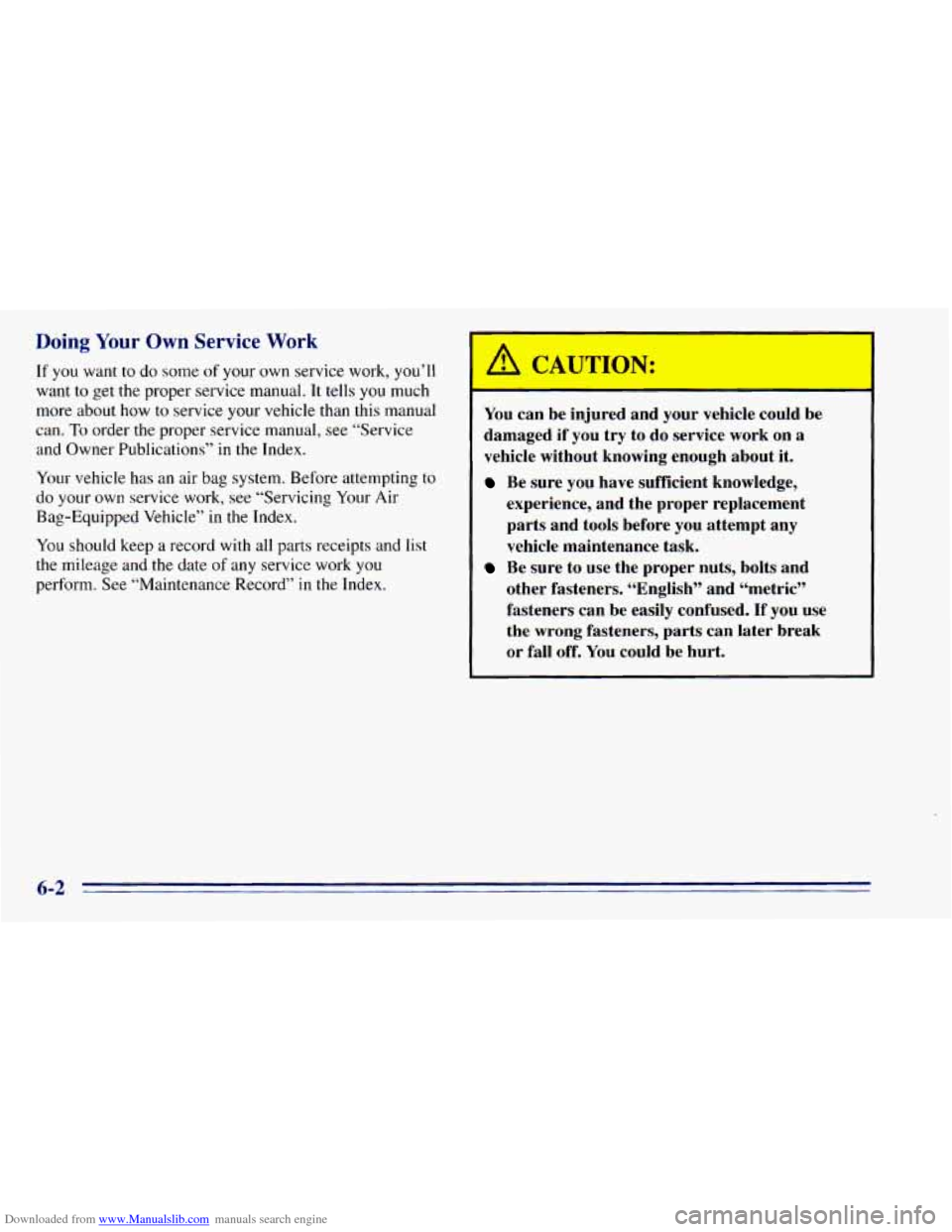
Downloaded from www.Manualslib.com manuals search engine Doing Your Own Service W(
If you want to do some of your own service work, you’ll
want to get
the proper service manual. It tells you much
more about how to service your vehicle than this manual
can.
To order the proper service manual, see “Service
and Owner Publications”
in the Index.
Your vehicle has an air bag system. Before attempting
to
do your own service work, see “Servicing Your Air
Bag-Equipped Vehicle” in the Index.
You should keep a record with all parts receipts and list
the mileage and the date
of any service work you
perform. See “Maintenance Record”
in the Index.
A CAUTION:
You can be injured and your vehicle could be
damaged if you try to do service work on
a
vehicle without knowing enough about it.
Be sure you have sufficient knowledge,
experience, and the proper replacement
parts and tools before you attempt any
vehicle maintenance task.
Be sure to use the proper nuts, bolts and
other fasteners. “English” and 44metric”
fasteners can be easily confused. If you use
the wrong fasteners, parts can later break
or
fall off. You could be hurt.
6-2